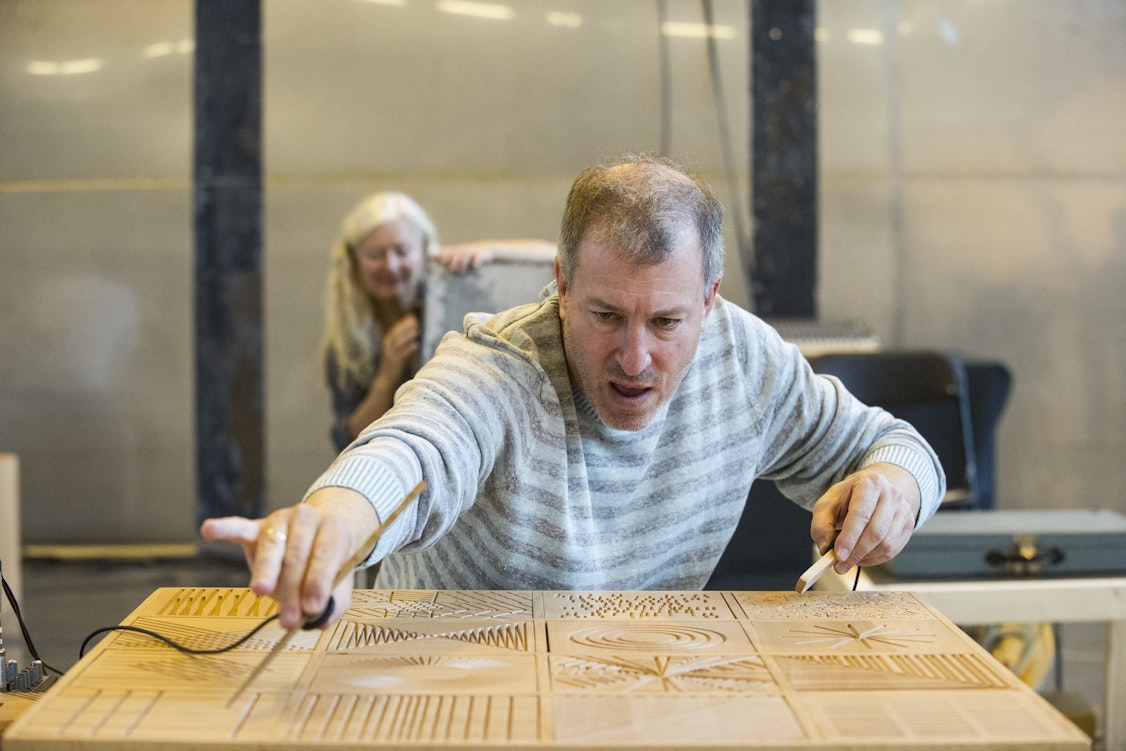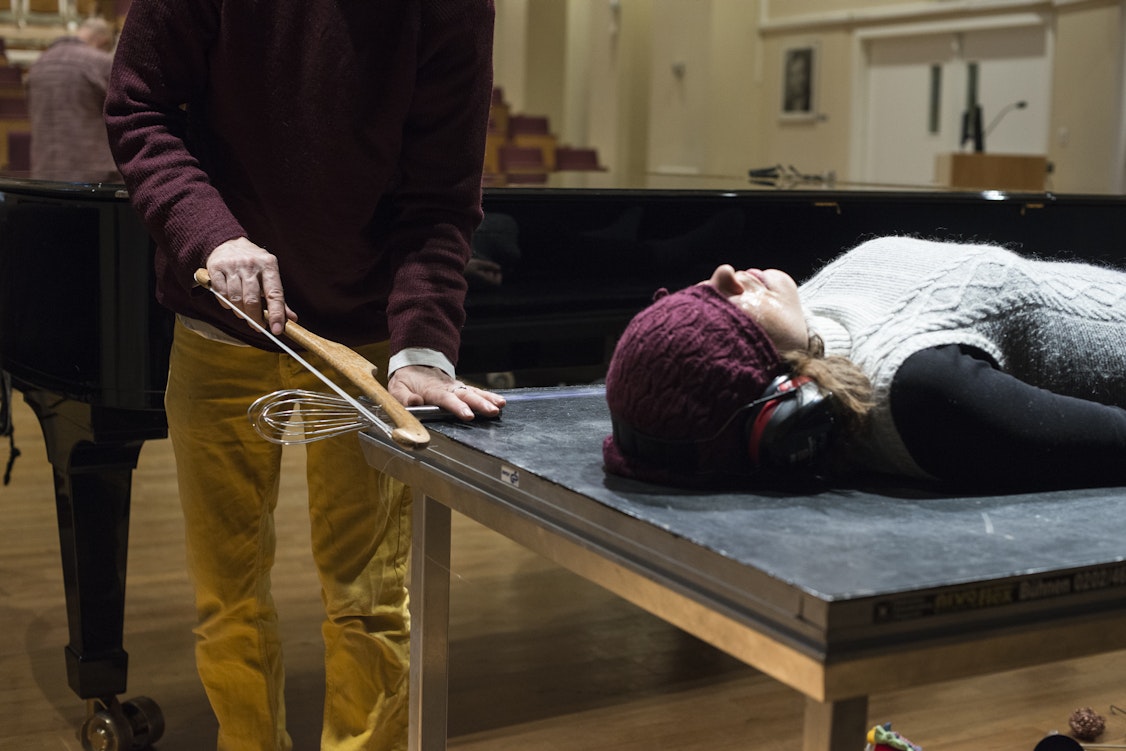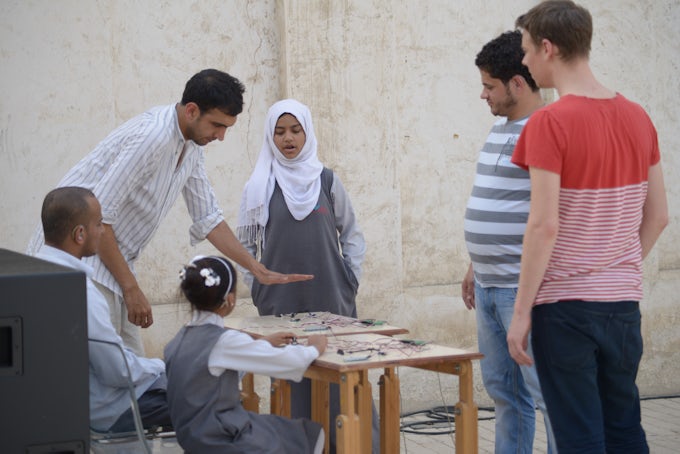The workshop Below 160 (2011) led by Lebanese-born sound artist and electro-acoustic composer Tarek Atoui in 2012 in Sharjah began with a performance of electronic music at frequencies below 160 hertz (bass and infra-bass sounds), during which the artist asked the participants, Deaf students from Al Amal School for the Deaf, to move around the public square where the sounds could be heard and to experience them.01 Reflecting on this episode in an interview with Council, an arts organisation with whom Atoui collaborated on the many chapters of his work with d/Deaf people, he recalled: ‘20 minutes into the performance, several students came on stage wanting to join and play with me. It was a meaningful moment in which the conventional distinctions between audience, stage, space, and musician collapsed. […] After this experience, Below 160 was transformed, and I left Sharjah with the will to return and keep on learning from the Al Amal school.’02 In this piece, Atoui sought to use sound as vibration with the intention of establishing a connection between his body and those of listeners. Although Atoui had performed the same piece to a hearing audience once before in Salzburg, as he recounts above, the desired effect and ensuing conversation with listeners became compelling only when he played it before a d/Deaf audience who expanded the realm of possibility of his sound performance.03 Below 160 represents an instance in which this new audience changed the artist’s understanding of how sounds could be performed and experienced. Atoui began his longstanding work with d/Deaf persons during a residency at the Sharjah Art Foundation in 2012. The first encounters, as he explained to me in a conversation over Zoom this past summer, ‘very much relied on where I come from, as somebody who makes electronic or noise music, [using] heavy or low-end frequencies. What took shape was a workshop that relied on using a lot of subwoofers, a lot of bass frequencies [while] trying to associate them with objects, with colours, with impressions and perceptions that d/Deaf people mobilise, [so for me] it was about understanding how they perceive these sounds as vibrations, as emotions, sometimes as movements […] the first encounter showed me how much there was to explore, starting with vibration, with immediate sound.’04
Prior to this formative sojourn in Sharjah, Atoui, an electro-acoustic musician and composer by training, had long been invested in articulating the ways in which sounds are generated and deployed both in the compositional process – through the creation of his own software and electronic instruments – and, most importantly, in performance – through his usage of infrared sensors whereby his body and movement become paramount in music-making and improvisation, most evident in his Un-drum/strategies of surviving noise series (2009–10). In Below 160, the artist’s use of low-frequency bass sounds emphasises, much like in his previous work, the articulation between body, sound and listener, but furthers the materiality of sound to underscore the physicality of sounds received by the audience.

Both the first encounter and subsequent workshops and performances with the students from Al Amal School for the Deaf, which Atoui held during another residency and educational programme at the Sharjah Art Foundation (as part of the Sharjah Biennial 11 in 2013),05 spurred a decade-long, large-scale series of durational projects and exhibitions begun in 2013 titled WITHIN and Infinite Ear, which encompass instrument-making, collective performances, workshops, talks, film programmes, and collaborations with hundreds of musicians, artists, scholars, designers and scientists. These ongoing projects place the expertise and knowledge of Deaf and hearing-impaired individuals at the centre of the artist’s investigation into modes of sonic perception that displace the act of listening from its phonocentric history. Such investigations only recently started gaining traction in the fields of sound studies and sound art.06 Atoui’s WITHIN and Infinite Ear both contribute critical insights into how Deaf communities understand sound and noise, how they may feel and perform them, but also provide pathways that might allow us to rid ourselves of the audism that remains prevalent in much of contemporary sound art. In these sprawling projects, Atoui’s foray into the sounds of Deafhood engages critically and collaboratively in narrowing the space between Sound studies’ sometimes phonocentric approach and Deaf studies’ often oculocentric epistemology’.07
The starting dates of the two projects reflect not their time of presentation or exhibition but their inception, emerging out of the initial encounters, workshops and performances made with the students from Al Amal School for the Deaf. The beginnings also stem from the research and later production of instruments that Atoui began with craftspeople around the world, a process that often requires painstaking and laborious exchanges between Atoui and his collaborators over a long period of time.
These two projects were anticipated by TACET (2013), the collaboration between Council and Atoui that framed the overall research inquiry at Sharjah. Council, an arts organisation founded by curators Sandra Terdjman and Grégory Castéra in 2013, had already began research on Deaf culture before embarking with Atoui on this trip to Sharjah. The organisation’s website, which contains a large and winding repository of texts, images and videos from the exhibition catalogues as well as accounts that relate to TACET, WITHIN and Infinite Ear, details how the first chapter came to be and includes fragments of past discussions and encounters that Council had initiated in Paris detailing the questions, observations and discoveries that led them to Sharjah and the students of Al Amal School for the Deaf. ‘We met with the students to ask them a few questions to try to understand which sounds they perceive and how they perceive them. We learned how a car can turn into a vibration chamber, how birdsong can help identify whether a space is silent or not, and how feet can become the best pair of ears when travelling in transport.’08 For Atoui ‘the way that “WITHIN” started to unfold [involved] fine tuning notions and perceptions, and it became less about low-end frequencies and sound intensity and much more about tactility, visualization of sound, sign language and sound.’09
The first iteration of WITHIN took place at Sharjah Biennial 11 and was conceived by Atoui as a single composition with four interconnected movements that spanned the entire duration of the exhibition. The first movement, ‘The Call – From The City Into The Biennial’, included two musical performances: Metricize, composed by Atoui and performed by ten drummers (who have distinct drumming styles and musical affinities) and an electronic composer fortissimo (ff), drew inspiration from Atoui and his collaborators, conversations with Al Amal students, later invited to attend and discuss; and Live Ammunition: Music for Clapping, String Quartet and Electronics, which was composed and performed by Egyptian contemporary artist and musician Hassan Khan. The third movement was TACET, the research component of WITHIN, comprising eight artists and academics from various disciplines who travelled to work with Atoui and Council on this project. The fourth and final movement consisted of a performance of Below 160 composed and performed by the students of Al Amal school.
-

Peter Kates, Tarek Atoui, WITHIN, Instrument Testing, Sentralbadet, Bergen Assembly, 2016. Photo: Thor Brødreskift -

Tarek Atoui, Thierry Madiot, Sound Massage workshop at Grieg Academy, University of Bergen
After the performance, Atoui and Council organised a discussion between the pupils and musicians during which the d/Deaf students relayed their experience of Metricize: ‘We felt your music in our entire body. For some players we felt [it] in our upper body, for others in our lower body. For you, we felt in the entire body. To give your music a metaphor, we felt like we were in a cold place, like layers of cold.’10 Because the piece relies heavily on drumming and vibration for both hearing and Deaf people, and because vibration is often understood as ‘a social and experiential space for hearing and deaf participants alike’, one might be led to think that Deaf and hearing persons experience it in the same way. Anthropologists Stefan Helmreich and Michele Friedner, whose propositions for an intersection of deaf studies and sound studies Castéra employs to lay bare the premises of Infinite Ear, problematise the use of vibration as an ‘infra-sensory force of unity’, reminding readers that vibration ‘may produce shared experience, but it does not therefore produce identical experience; even within “one” individual, sense ratios and relations may shift and mix synesthetically. Phenomenologies of vibration are not singular.’11
In 2016, three years after WITHIN was first presented, the second instalment of WITHIN/Infinite Ear was held at Bergen Assembly, where Atoui was also artistic co-director, again in collaboration with Council. Atoui describes the aesthetic and conceptual movements from one instalment to the next as the perception of sounds shifted: ‘from feeling sound through the body, we [began] to feel sound with the fingers, with the skeleton, the teeth, with the bones. We also [moved towards] seeing and understanding sound and its presence through the movement of objects, like visual stimuli and indicators.’12
In the introduction to the exhibition catalogue, Castéra explains that ‘Infinite Ear approaches profound deafness – a hearing condition ostracized by modern conceptions of hearing – as both an ability (or even expertise) and a starting point from which an alternative to the phonocentric natural history of hearing might be established’. The exhibition’s inquiry thus attempts to align with Deaf scholars H-Dirksen L. Bauman and Joseph J. Murray who reframed the loss of hearing as ‘deaf gain’, ‘a form of sensory and cognitive diversity that has the potential to contribute to the greater good of humanity.’13 Media and Deafhood scholar Mara Mills,14 who refers to the term advanced by Bauman and Murray in her essay ‘Deafness’, expounds further that ‘these gains range from the neurodiversity that accompanies visual-gestural languages to aesthetic and technical innovations. With regard to technology, gains often occur because inaccessible media systems necessitate adaptations; examples include closed captioning (sound-to-text translation) and telephone relay services.’15 One example of the rich terrain of visual-gestural languages that Mills discusses is evident in a series of short videos produced during TACET that show architect and designer Jeffrey Mansfield – a key collaborator who worked with Atoui and Council not only on TACET and WITHIN/Infinite Ear, but also on the workshop ‘Deaf Sound’ at MoMA PS1 in New York in 2014 – and the students of Al Amal school describing with gestural expressions the sounds of machines like airplane engines, sewing machines and motorcycles.

Several crucial components distinguished WITHIN/Infinite Ear from the previous instalment in Sharjah and allowed it to depart from bass frequencies and gestural work towards the spatial, aesthetic and curative concerns that Atoui continues to hone in on in more recent sound-based performances and exhibitions. Staged in a public indoor swimming pool in Bergen, the exhibition included nine musical instruments that were conceived with and for hearing and Deaf people and built over several years with designers, instrument makers and software engineers at different institutions, such as University of California, Berkeley Art Museum & Pacific Film Archive as part of their MATRIX series and EMPAC – The Curtis R. Priem Experimental Music and Performing Arts Center in Albany to name only two. First created for the Bergen Assembly, the nine instruments were activated by Deaf amateur musicians who rehearsed and played them as part of an orchestra. Pauline Oliveros, the late American experimental composer and founder of Deep Listening and whose oeuvre was a key influence for the exhibition, composed a piece for the opening concert. Each instrument was intricately conceived with Deaf persons and designed and fabricated with materials that conducted sound either through tactility or resonant frequencies. Musicians could play them with different parts of their bodies directed by distinct sensorial movements. Other activities in the Bergen chapter included sonic and therapeutic exercises performed using the instruments that were originally produced for the exhibition ‘WITHIN’, conducted by artists Lendl Barcelos, Valentina Desideri and Myriam Lefkowitz in collaboration with choreographer Catalina Insignares. The White Cat café, where visitors could listen to 30 recordings of inaudible phenomena by musicians and recordists like Jacob Kirkegaard, Chris Watson and Éric La Casa was another component of the exhibition.16 A film programme of video works by artists such as Lawrence Abu Hamdan, Christian Marclay and Walter Ruttmann, and a display of objects and artworks that charted different hearing experiences across time, supplemented the exhibition. The attention to the discursive and critical framework was also manifest in the form of a reader assembled and edited by the artist and writer Emma McCormick-Goodhart, which featured the most recognised artists, authors and scholars working in the fields of sound studies, deaf studies and experimental music.17 Since the Bergen Assembly, Infinite Ear has travelled to Moscow and Madrid, exploring in each instalment issues pertaining to the local Deaf communities, whether they relate to the politics and physics of space and institutions, or deploy strategies of care and mediation.
While each instalment of these two projects yields its own set of distinct aesthetic, collaborative and performative idiosyncrasies, they are all interrelated in the way they develop by building on accumulated knowledge from additional collaborators in different contexts. Beyond the d/Deaf participants’ experience of sound from which the projects and enquiries departed from, Atoui’s insistence on the importance of tactility and visuality, not in opposition to hearing as they have been regarded in the past, but as essential components to understanding listening and performance, create unique circumstances for the missed articulations between sound and Deafness evoked by Friedner and Helmreich. By proposing and creating spaces for different modes of engagement with sound, Atoui moves beyond from the purported singularity of vibration as a site for shared experiences for d/Deaf and hearing audiences to a vast terrain that continually reminds us about the ways in which Deaf practices have always contributed, and will continue to contribute, to understanding sound.
Footnotes
-
A conversation between Brian Chippendale, Cevdet Erek, Bassem Abdel Ghaffar, Lukas Ligeti, Al Amal students and Sandra Terdjman, ‘Drumming like a dog barking’, available at http://www.council.art/inquiries/30/infinite-ear/53/drumming-like-a-dog-barking (last accessed on 11 September 2022). This quote is a translation of an intervention by a participating Deaf student who signed it, after which it was translated into Arabic then English.
-
Tarek Atoui and S. Terdjman, ‘When We Met’, Council [website], available at http://www.council.art/inquiries/30/infinite-ear/791/when-we-met (last accessed on 9 September 2022).
-
Deaf Space and Making Musical Instruments [online video], Arts Research Center – University of California Berkeley, 14 April 2015, available at https://www.youtube.com/watch?v=6X8JwKAzuIg (last accessed on 1 September 2022).
-
Conversation with the artist, 11 August 2022.
-
Sharjah Biennial 11: Re:emerge – Towards a New Cultural Cartography, 13 March–13 May 2013.
-
For more on the field of sound studies, see Jonathan Sterne, The Audible Past: Cultural Origins of Sound Reproduction, Durham, NC: Duke University Press, 2003 and Viktoria Tkaczyk, Mara Mills and Alexandra Hui, Testing Hearing: The Making of Modern Aurality, Oxford: Oxford University Press, 2020; for more on sound art, see the body of work of Korean-American sound artist Christine Sun Kim.
-
Michele Friedner and Stefan Helmreich, ‘Sound Studies Meets Deaf Studies’, The Senses & Society, vol.7, no.1, 2012, p.80.
-
Council, ‘TACET (2013)’, available at http://www.council.art/inquiries/30/infinite-ear/1186/tacet-2013 (last accessed on 9 September 2022).
-
Conversation with the artist, 11 August 2022.
-
A conversation between B. Chippendale et al., ‘Drumming like a dog barking’, op. cit.
-
M. Friedner and S. Helmreich, ‘Sound Studies Meets Deaf Studies’, op. cit., pp.72–86.
-
Conversation with the artist, 11 August 2022.
-
H-Dirksen L. Bauman and Joseph J. Murray, ‘Reframing: From Hearing Loss to Deaf Gain’, Deaf Studies Digital Journal, no.1, Fall 2009, pp.1–10.
-
Mara Mills contributed to Infinite Ear in Moscow with an interview with Vlad Kolesnikov, a deaf educator, sign language interpreter, and museum access and inclusive programmes expert in Moscow. See M. Mills, ‘Detours [a portrait of Vlad Kolesnikov], Council [website], available at http://www.council.art/inquiries/30/infinite-ear/1204/detours-a-portrait-of-vlad-kolesnikov (last accessed on 10 September 2022).
-
M. Mills, ‘Deafness’, Keywords in Sound, Durham, NC: Duke University Press, 2015, p.45.
-
For full disclosure, I served as researcher and editor for the White Cat café project.
-
Emma McCormick-Goodhart (ed.), Infinite Ear: A Reader [online], Bergen Assembly, 2016, available at http://www.council.art/inquiries/30/infinite-ear/1041/infinite-ear-a-reader (last accessed on 27 September 2022).
